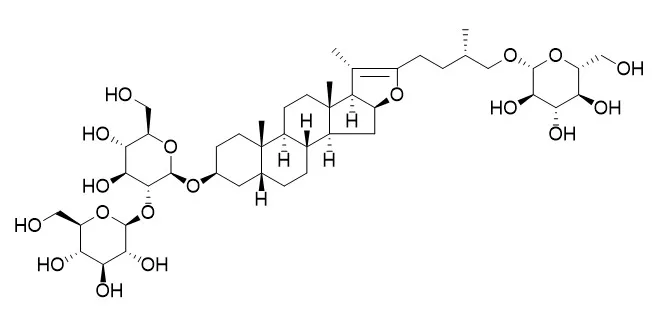| Yao Xue Xue Bao. 1992;27(1):26-32. |
| [Studies on the active constituents of Anemarrhena asphodeloides bunge].[Pubmed: 1529709] |
METHODS AND RESULTS:
From the ethanol extract of the Anemarrhena asphodeloides Buge (Liliaceae), a new steroidal suponin Anemarsaponin B and two known saponins anemarsaponin A1 and A2 were isolated. On the basis of chemical evidences and spectral analysis (UV, IR, EI-MS, FAB-MS, 1H-NMR and 13C-NMR), the structure of Anemarsaponin B was elucidated as 26-O-beta-D-glucopyranosylfurost-20(22)-ene-3 beta,26-diol-3-O-beta-D- glucopyranosyl(1----2)-beta-D-galactopyranoside.
CONCLUSIONS:
Preliminary pharmacological tests showed that Anemarsaponin B could inhibit PAF-induced rabbit platelet aggregation in vitro. |
| Planta Med. 1991 Oct;57(5):460-2. |
| A new active steroidal saponin from Anemarrhena asphodeloides.[Pubmed: 1798801] |
METHODS AND RESULTS:
A new active steroidal saponin, Anemarsaponin B, was isolated from the rhizomes of Anemarrhina asphodeloides. The structure of Anemarsaponin B was elucidated as 26-O-beta-D-glucopyranosylfurost-20(22)-ene-3 beta, 26-diol-3-O-beta-D-glucopyranosyl-(1----2)-beta-D-galactopyranoside by chemical and spectral studies.
CONCLUSIONS:
Preliminary pharmacological tests showed that Anemarsaponin B could inhibit PAF-induced rabbit platelet aggregation in vitro. |
| Food Chem Toxicol . 2009 Jul;47(7):1610-7. |
| Anti-inflammatory effect of anemarsaponin B isolated from the rhizomes of Anemarrhena asphodeloides in LPS-induced RAW 264.7 macrophages is mediated by negative regulation of the nuclear factor-kappaB and p38 pathways[Pubmed: 19375480] |
| Abstract
Anemarrhena asphodeloides is widely used in traditional Chinese medicine, and is known to have anti-diabetic and diuretic effects. In this study, we evaluated the anti-inflammatory effects of Anemarsaponin B (ASB), a steroidal saponin isolated from the rhizomes of A. asphodeloides (Liliaceae), in LPS-stimulated RAW 264.7 macrophage cell line. ASB significantly and dose-dependently decreased the protein and mRNA levels of inducible nitric oxide synthase (iNOS) and cyclooxygenase-2 (COX-2). ASB also reduced the expressions and productions of pro-inflammatory cytokines, including those of tumor necrosis factor-alpha (TNF-alpha) and interleukin-6 (IL-6). Electrophoretic mobility shift assay (EMSA) and reporter gene assays revealed that ASB attenuated the LPS-induced DNA binding and transcriptional activity of nuclear factor-kappa B (NF-kappaB). In addition, it was found that pretreatment with ASB significantly inhibited the nuclear translocation of the p65 subunit of NF-kappaB by blocking the phosphorylation of inhibitory kappa B-alpha (IkappaB-alpha). On the other hand, ASB inhibited the phosphorylation of MAP kinase kinases 3/6 (MKK3/6) and mixed lineage kinase 3 (MLK3), which are both involved in the p38 pathway. Taken together, these results suggest that anti-inflammatory effect of ASB in LPS-treated RAW 264.7 macrophages is associated with the inhibition of NF-kappaB transcriptional activity, possibly via the p38 MAP kinase pathway. |






 Cell. 2018 Jan 11;172(1-2):249-261.e12. doi: 10.1016/j.cell.2017.12.019.IF=36.216(2019)
Cell. 2018 Jan 11;172(1-2):249-261.e12. doi: 10.1016/j.cell.2017.12.019.IF=36.216(2019) Cell Metab. 2020 Mar 3;31(3):534-548.e5. doi: 10.1016/j.cmet.2020.01.002.IF=22.415(2019)
Cell Metab. 2020 Mar 3;31(3):534-548.e5. doi: 10.1016/j.cmet.2020.01.002.IF=22.415(2019) Mol Cell. 2017 Nov 16;68(4):673-685.e6. doi: 10.1016/j.molcel.2017.10.022.IF=14.548(2019)
Mol Cell. 2017 Nov 16;68(4):673-685.e6. doi: 10.1016/j.molcel.2017.10.022.IF=14.548(2019)